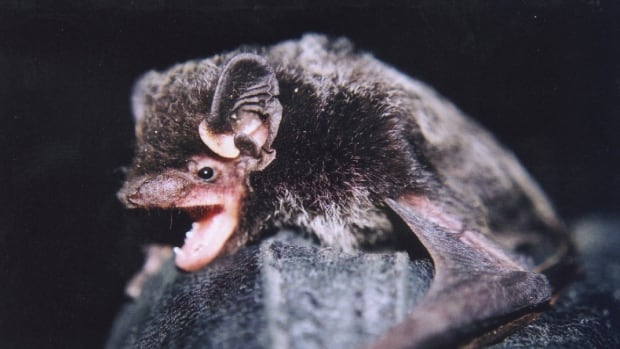The Dose28:24What do I need to know about rabies?
Dr. Scott Weese doesn’t mess around when it comes to rabies.
An infectious-diseases veterinarian, Weese recalls when he, his family, as well as some visitors all had to receive vaccinations after being exposed to a potentially rabid bat.
“It was a bit of a mess, but it … shows a lot of things we need to consider when it comes down to who actually is exposed,” he told The Dose host Dr. Brian Goldman.
Human cases of rabies are extremely rare in Canada, but some people do still come into contact with rabid animals. A Brantford, Ont., child recently died after coming into contact with an infected bat, in the province’s first domestically acquired case of rabies since 1967.

Not only is it relatively simple to avoid exposure to the disease, experts say, but there are also effective treatments available for both humans and animals who may have been exposed, including vaccines.
What is rabies, and how does it spread?
Rabies is transmitted when an infected mammal’s contaminated saliva gets into a new mammalian host through a bite, lick or scratch.
The virus travels through the victim’s peripheral nervous system, according to Dr. Isaac Bogoch, an infectious-diseases specialist. It eventually settles into the central nervous system.
“Initial symptoms are non-specific fever, chills, sometimes headache, sometimes muscle aches and pain,” said Bogoch, speaking to The Dose host Dr. Brian Goldman.
Without treatment, eventually, one of two conditions develops: encephalitic rabies or paralytic rabies, which is less common.
“Basically, the final common pathway, sadly, is coma and death,” said Bogoch.
Another sign of possible rabies infection is a condition known as hydrophobia. Someone infected with rabies will experience muscle spasms in their throat and diaphragm when presented with liquids. Aerophobia, a fear of drafts or puffs of air, is another sign.
Paralytic rabies is sometimes called dumb rabies, and is a “flaccid paralysis that may descend through the body,” according to Bogoch.
People with paralytic rabies slowly lose the ability to move parts of their bodies, beginning with the initially infected body part. If left untreated, patients fall into a coma and eventually die.
Rabies has an incredibly high fatality rate when left untreated, almost always leading to death.
Animals present similar symptoms as humans, according to Weese, and the disease has the same incredibly high fatality rate of almost 100 per cent.
How common is rabies?
While global rabies fatalities range from 50,000 to 60,000 per year, Canadian numbers are significantly lower.
Canada has been tracking human rabies cases since 1924 and only 28 people have died across six provinces in that time. The most recent death was the child from Brantford.
Weese says bats are the most common carriers of rabies in Canada.
A Brantford, Ont., child has died from rabies after contact with a bat in the first domestically acquired case of human rabies in the province since 1967. Health officials believe the child was exposed to the disease in the Temiskaming region, north of Sudbury.
“It’s a low percentage of bats [that carry rabies], but because there are so many bats and they can get in human environments, that’s a concern,” he said.
The Canadian Food Inspection Agency reports 95 bats have tested positive for rabies in 2024 to date.
Skunks, foxes and raccoons are also rabies reservoir species.
Smaller mammals, like squirrels and chipmunks, are less likely to spread rabies simply because they’re less likely to survive an initial attack that would infect them in the first place.
“Most of the time, if a squirrel or mouse has an encounter with a rabid animal, the squirrel or the mouse isn’t going to come out of that alive,” said Weese.
Cats and dogs can get rabies, and the World Health Organization estimates roughly 99 per cent of human rabies cases globally are caused by dog bites and scratches.
In Canada, however, rabies vaccines for dogs and cats mean that those animals are less likely to spread the virus to humans.
How do I protect myself against rabies?
Bogoch recommends contacting a medical professional in the event of an animal bite — even if the animal doesn’t appear to be rabid.
He adds that people should seek post-exposure care after coming into contact with a potentially rabid animal, even if there’s no evidence of a bite or scratch.
The family of the Brantford child who died didn’t immediately seek care because there wasn’t any physical evidence of exposure, according to the Haldimand-Norfolk Health Unit.
Rabies vaccines are available for people who are exposed to rabid animals, as well as rabies immunoglobulin, which contains antibodies that prevent rabies disease after exposure.
“If you seek care right away and get the appropriate vaccination and immunoglobulin, it would be extremely unusual for someone to develop rabies after that,” said Bogoch.
The Quebec ministry of forests, wildlife and parks is trying to vaccinate raccoons for rabies by dropping tasty treats containing medicine from low-flying planes.
Post-exposure treatment is most effective before the onset of symptoms. Rabies is almost always fatal after symptoms appear.
Both Bogoch and Weese describe rabies infections as highly preventable.
“For me, every rabies case in North America is a public health failure,” said Weese.
“Not because public health screwed up, but because globally we didn’t have enough education out there.”
Be wary of wild animals
One of the easiest ways to avoid getting rabies from an infected wild animal is by avoiding them as much as possible.
“If you’re not within biting distance of an animal, it’s not going to bite you,” said Weese.
That means not feeding raccoons, squirrels or chipmunks; keeping outdoor garbage bins and food waste covered; as well as exercising responsible pet ownership by vaccinating cats and dogs.
“Making sure that dogs are trained properly, supervised properly,” said Weese.
Pets can get infected with rabies if they encounter a rabid animal in the wild, and an infected pet can potentially infect their owners.
“Just because your cat’s indoors, doesn’t mean there’s no risk of rabies,” said Weese.
“You’d be surprised how many indoor cats we see … tangle with wildlife because they sneak out.”
Small children should also be taught how to behave around wild animals to avoid potential infection.
Weese says public health initiatives are in place to vaccinate some wild animals — like raccoons and foxes — against rabies in the first place.
There have been wide-scale efforts to airdrop oral vaccine baits from helicopters, Weese says, as well as set up bait stations where raccoons feed.
“These aren’t easy and they’re not cheap, but if we can eliminate a rabies variant from a species like raccoons in particular that live very closely with us, that’s money well spent.”








